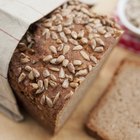
Christian Draghici/iStock/Getty Images
When bleached flour and unbleached flour are placed side by side, the most obvious difference is the color. Bleached flour is snowy white, while unbleached has a yellowish tint. But the differences go much deeper. Bleaching alters the protein levels in flour and that, in turn, affects the texture of baked goods. Although some health-conscious individuals steer clear of bleached flour due to its chemical alteration, bleached flour does have its advantages when it comes to baking.
Bleached Flour: Whiter and Lighter
Bleached flour is widely used in the United States. Even though all flour naturally ages and lightens over time due to oxidation, the natural process takes weeks and doesn't always produce a consistent product. Bleaching the flour -- the chemical method of adding potassium bromate, chlorine dioxide, benzoyl peroxide or chlorine gas during milling -- hastens the aging process. Aging the flour develops a stronger gluten that enhances the final product, according to Dr. Manfred Dirndorfer, head of the Bakery Innovation Center at Buhler Technologies. Besides quickly aging the flour, bleaching also changes its protein molecules, which isn't necessarily a bad thing. The lower protein of bleached flour results in baked goods that are lighter and more tender. For example, many bakers use bleached flour for cakes, pie crusts, pancakes and pastries. Bleached flour is also often used in baked goods where whiteness is a priority, such as angel food cake.
On the downside, bleached flour is not considered a natural product and it must be labeled. According to the Health Research Funding website, many nutrients -- including vitamin B, vitamin E, iron, calcium, phosphorus, magnesium and unsaturated fatty acids -- are lost during the bleaching process.
Unbleached Flour: A Natural Alternative
Unbleached flour is aged naturally by exposing it to air up to several weeks after milling. It contains higher levels of gluten, and its off-white appearance is a result of the absence of the oxidizing chemical additives. Unbleached flour can be substituted in equal parts for its bleached counterpart; however, the higher protein levels will change the consistency of the product. For example, while cakes and pastries baked with unbleached flour may suffer with a texture that is denser and heavier, unbleached flour is recommended for yeast breads. Cookies also generally fare well when baked with unbleached flour.
Because unbleached flour has a higher gluten content, it's wise for those with gluten issues to opt for another natural alternative such as coconut, tapioca or oat flour.
Bread and Cake Flours
Cake flour is a bleached wheat flour that has been milled into a finer texture than all-purpose flour. It is lower in protein than all other wheat flours, according to the What's Cooking America website. Cake flour ensures a better rise and soft texture. It can also be used in muffins and pound cake. Alternatively, bread flour is unbleached. Because it produces more gluten strength, it is recommended for bread and other yeast products.
Enrichment Process
During the milling process, flour loses its natural iron and B vitamins. Enriching restores those nutrients -- and adds small amounts of niacin, thiamine and riboflavin -- to all-purpose flour. The process of enriching all-purpose flour has been required by the Food and Drug Administration since the 1940s. The enrichment process does not alter the taste, quality or texture of the flour, according to the Pillsbury website.
Shelf Life and Storage
Whether flour is bleached or unbleached, it should be stored in an airtight container in a cool, dry place. An airtight container prevents it from absorbing moisture and odors. If you choose to store flour in the refrigerator, allow it to return to room temperature before using it. Flour also can be kept for several years when it's properly frozen in airtight containers.
The Pillsbury website suggests flour should be used within 18 to 24 months. However, the What's Cooking America website recommends discarding unused flour within 6 months after it has been exposed to the air due to the possibility of rancid off-flavors.
Related Articles

Can I Substitute Bleached for ...

Can You Substitute Whole Wheat Pastry ...

Bread Flour vs. Cake Flour in Sponge ...
Can I Grind Quinoa?

What Kind of Flour to Use for Cupcakes?
Is Unbleached Flour the Same as ...
What Is the Difference Between Cake ...

Chemicals in Enriched Flour
Can You Substitute Whole-Wheat Pastry ...

What Additives Are in Flour?

Does it Help to Keep Flour in the ...

Is Soy Flour Healthy?

If Flour Has Never Been Opened Can It ...

Does Flour Expire?

Whole Wheat Pastry: Flour Substitutions

Does Unbleached Bread Flour Make ...
What Kind of Flour Do You Use for a ...
What Gives Pumpernickel Bread Its Dark ...

Russian Rye Bread vs. Pumpernickel

How to Substitute Cornstarch for ...
References
Writer Bio
Lisa Swickard began her writing career in 1982. She is the owner of Virgin Alley Press, an Ohio-based publishing company. Swickard is an award-winning author who recently released her ninth book. She also is a writer/editor for Tiffin University. Swickard has a journalism degree from Bowling Green State University.
Photo Credits
Christian Draghici/iStock/Getty Images